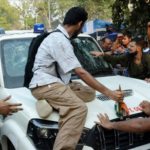Kolkata Rape and murder case in Kolkata has sparked outrage across India, drawing attention to the safety and security of healthcare professionals, who are often at risk while performing their duties. In the wake of this tragic incident, there has been an outcry for better protection of healthcare workers, with many calling for the enactment of a Central law specifically aimed at safeguarding doctors and other medical staff. However, the Union government has responded by stating that there is no need for a new Central law, as States already have laws in place to protect healthcare employees at work. In addition, the Health Ministry has announced plans to increase security at healthcare facilities under the Centre’s jurisdiction by 25%.
This article explores the complexities surrounding the protection of healthcare workers in India, delving into the existing legal framework, the specific challenges faced by medical professionals, and the implications of the Union government’s decision. We will also examine the broader issues of violence against healthcare workers and what can be done to ensure their safety in the future.
The Kolkata Rape Incident: A Tragic Reminder of Vulnerability
The Kolkata rape and murder case has sent shockwaves through the nation. The incident involved the brutal assault and killing of a healthcare professional, bringing to light the extreme dangers faced by those who dedicate their lives to caring for others. While this case is particularly harrowing, it is not an isolated incident. Healthcare workers in India have long been vulnerable to violence, whether from disgruntled patients and their families or from external threats.
This tragic event has reignited the debate on the need for stronger legal protections for doctors and healthcare workers. Many in the medical community argue that the existing laws are inadequate and that a Central law is necessary to ensure uniform protection across the country. However, the Union government has taken a different stance, asserting that the current legal framework, if properly enforced, is sufficient to safeguard healthcare professionals.
Existing Legal Framework Kolkata Rape: State Laws on Healthcare Protection
The Union government’s position is that States already have laws in place to protect healthcare workers, and that these laws, if effectively implemented, can provide the necessary security. Various States in India have enacted specific legislation aimed at preventing violence against healthcare professionals. For instance:
- Maharashtra: The Maharashtra Medicare Service Persons and Medicare Service Institutions (Prevention of Violence and Damage or Loss to Property) Act, 2010, provides for stringent penalties for those who commit acts of violence against healthcare service personnel or damage healthcare facilities.
- Karnataka: The Karnataka Prohibition of Violence against Medicare Service Personnel and Damage to Property in Medicare Service Institutions Act, 2009, criminalizes acts of violence against healthcare workers and institutions, with provisions for imprisonment and fines.
- Andhra Pradesh: The Andhra Pradesh Medicare Service Persons and Medicare Service Institutions (Prevention of Violence and Damage or Loss to Property) Act, 2008, was among the first laws in India to specifically address violence against healthcare workers.

These State laws typically include provisions for punishment, ranging from fines to imprisonment, for anyone found guilty of assaulting healthcare workers or damaging healthcare facilities. The laws also mandate that cases of violence against healthcare workers be treated as cognizable and non-bailable offenses, ensuring that perpetrators are dealt with swiftly and effectively.
Challenges in Implementation: Enforcement and Awareness
While these laws exist on paper, their effectiveness in practice is often called into question. One of the main challenges is the inconsistent enforcement of these laws across different States. In many cases, healthcare workers may not even be aware of the legal protections available to them, leading to underreporting of incidents and a lack of accountability for perpetrators.
Moreover, the implementation of these laws often depends on the cooperation of local law enforcement agencies, which may be overburdened or lack the resources to adequately protect healthcare workers. This inconsistency in enforcement has led to calls for a Central law, which proponents argue would provide uniform protection and ensure that all healthcare workers across the country are equally safeguarded.
The Union Government’s Stance: No Central Law Needed
Despite these concerns, the Union government has maintained that a new Central law is unnecessary. According to officials, the existing State laws, if properly implemented, are sufficient to protect healthcare workers. The government’s stance is based on the belief that law and order is a State subject under the Indian Constitution, and that States are best positioned to address the specific needs and challenges of their healthcare systems.
The Union government has also pointed out that creating a Central law might lead to jurisdictional conflicts, further complicating the enforcement of protections for healthcare workers. Instead, the focus should be on strengthening the implementation of existing laws and ensuring that healthcare workers are aware of their rights and the protections available to them.
Health Ministry’s Response: Increasing Security at Central Healthcare Facilities
In response to the Kolkata incident and the broader concerns about the safety of healthcare workers, the Health Ministry has announced plans to increase security at healthcare facilities under the Centre’s jurisdiction by 25%. This move is intended to provide immediate relief and reassurance to healthcare workers, ensuring that they can perform their duties without fear of violence or harassment.
The Health Ministry’s plan includes several key measures:
- Deployment of Additional Security Personnel: The Ministry will increase the number of security personnel at healthcare facilities, particularly in sensitive areas where the risk of violence is higher. This will involve the deployment of both government security forces and private security agencies, depending on the specific needs of each facility.
- Installation of Surveillance Systems: To deter potential perpetrators and aid in the swift identification of those who commit acts of violence, the Ministry will install additional surveillance cameras in and around healthcare facilities. This will include both public areas and sensitive zones within hospitals and clinics.
- Strengthening Emergency Response Protocols: The Ministry will enhance emergency response protocols, ensuring that healthcare facilities are equipped to quickly respond to incidents of violence. This includes establishing rapid response teams that can intervene in case of an emergency and provide immediate support to healthcare workers.
- Training and Awareness Programs: To ensure that healthcare workers are prepared to deal with potential threats, the Ministry will implement training and awareness programs focused on personal safety, conflict resolution, and the legal protections available to them. These programs will be tailored to the specific needs of different healthcare facilities and staff.
Implications of the Government’s Decision
The Union government’s decision not to enact a Central law for the protection of healthcare workers has significant implications for the medical community and the broader public. On one hand, it highlights the government’s belief in the sufficiency of existing State laws and its commitment to improving their implementation. On the other hand, it raises questions about whether the current legal framework is adequate to address the unique challenges faced by healthcare workers in different parts of the country.
1. State vs. Central Responsibility:
The decision to rely on State laws underscores the government’s stance that law and order is primarily a State responsibility. This approach is consistent with the federal structure of India, where States have considerable autonomy in managing internal affairs, including public safety. However, critics argue that a Central law would provide a more consistent and uniform approach to protecting healthcare workers, reducing the disparities in enforcement that currently exist between States.
2. Focus on Implementation:
The government’s emphasis on improving the implementation of existing laws rather than creating new legislation is a pragmatic approach, given the challenges of enforcement in a diverse and populous country like India. However, this approach also places the onus on State governments to take proactive measures to protect healthcare workers, which may not always be feasible given the varying capacities and resources of different States.
3. Public Perception and Trust:
The decision not to introduce a Central law may also affect public perception and trust in the government’s commitment to protecting healthcare workers. In the wake of high-profile incidents like the Kolkata case, there is often a strong public demand for decisive action, including the enactment of new laws. By opting for a more measured approach, the government risks being perceived as not doing enough to address the concerns of healthcare workers and the public.
Violence Against Healthcare Workers: A Broader Issue
The Kolkata rape and murder case is part of a larger pattern of violence against healthcare workers in India and around the world. Healthcare professionals, particularly those working in high-pressure environments like emergency rooms and intensive care units, are often exposed to violence from patients and their families, who may be frustrated or angry about the outcomes of medical treatment.
1. Causes of Violence:
There are several factors that contribute to violence against healthcare workers, including:
- High Patient Expectations: In many cases, patients and their families have unrealistic expectations about the outcomes of medical treatment. When these expectations are not met, it can lead to frustration and anger, which may be directed at healthcare workers.
- Poor Communication: A lack of clear communication between healthcare workers and patients or their families can lead to misunderstandings, which can escalate into conflict. Effective communication is crucial in managing patient expectations and preventing violence.
- Overcrowded Healthcare Facilities: Overcrowded hospitals and clinics, particularly in urban areas, can create a stressful environment for both patients and healthcare workers. The high volume of patients and limited resources can lead to delays in treatment, which may provoke violent reactions.
- Inadequate Security Measures: Many healthcare facilities, particularly in rural or underfunded areas, lack adequate security measures to protect healthcare workers from violence. This includes a lack of trained security personnel, surveillance systems, and emergency response protocols.
2. The Impact of Violence:
Violence against healthcare workers has far-reaching consequences, not only for the individuals involved but also for the broader healthcare system. The impact of such violence includes:
- Physical and Psychological Harm: Healthcare workers who are victims of violence can suffer physical injuries as well as long-term psychological trauma. This can affect their ability to perform their duties and may lead to burnout or a decision to leave the profession.
- Disruption of Healthcare Services: Incidents of violence can disrupt the delivery of healthcare services, leading to delays in treatment and potentially compromising patient care. In some cases, healthcare workers may refuse to work in high-risk areas, further exacerbating the problem.
- Erosion of Trust: Violence against healthcare workers can erode trust between healthcare providers and the communities they serve. Patients may become reluctant to seek medical care if they perceive healthcare facilities as unsafe, while healthcare workers may become distrustful of patients and their families.
Conclusion: Ensuring the Safety of Healthcare Workers
The Kolkata rape and murder case has once again highlighted the urgent need to protect healthcare workers in India. While the Union government has decided against enacting a Central law, it is clear that more needs to be done to ensure the safety and security of those who dedicate their lives to caring for others.
The government’s focus on improving the implementation of existing State laws and increasing security at Central healthcare facilities is a step in the right direction. However, it is also crucial to address the root causes of violence against healthcare workers, including improving communication, managing patient expectations, and ensuring that healthcare facilities are adequately staffed and resourced.
Ultimately, the protection of healthcare workers is not just a legal issue, but a moral imperative. As a society, we must do everything in our power to ensure that those who care for us are themselves cared for and protected from harm. By working together—government, healthcare providers, and the public—we can create a safer and more supportive environment for healthcare workers, allowing them to continue their vital work without fear of violence or harassment. Indian Coast Guard Director-General Rakesh Pal Passes Away in Chennai: A Sudden Loss of a Respected Leader 2024





